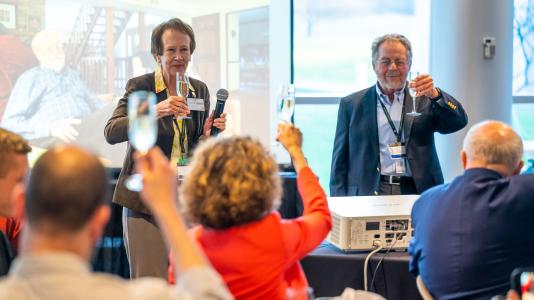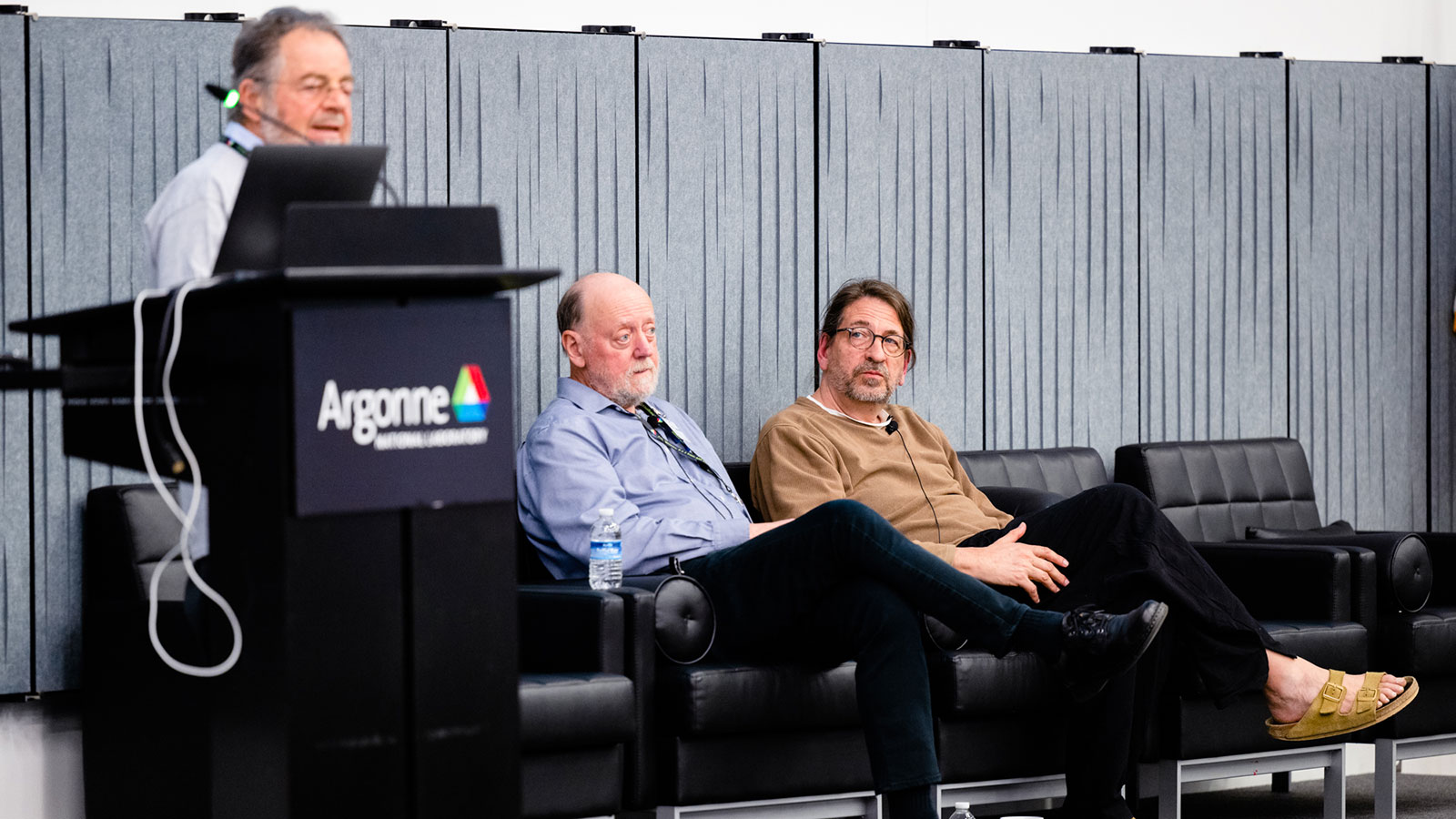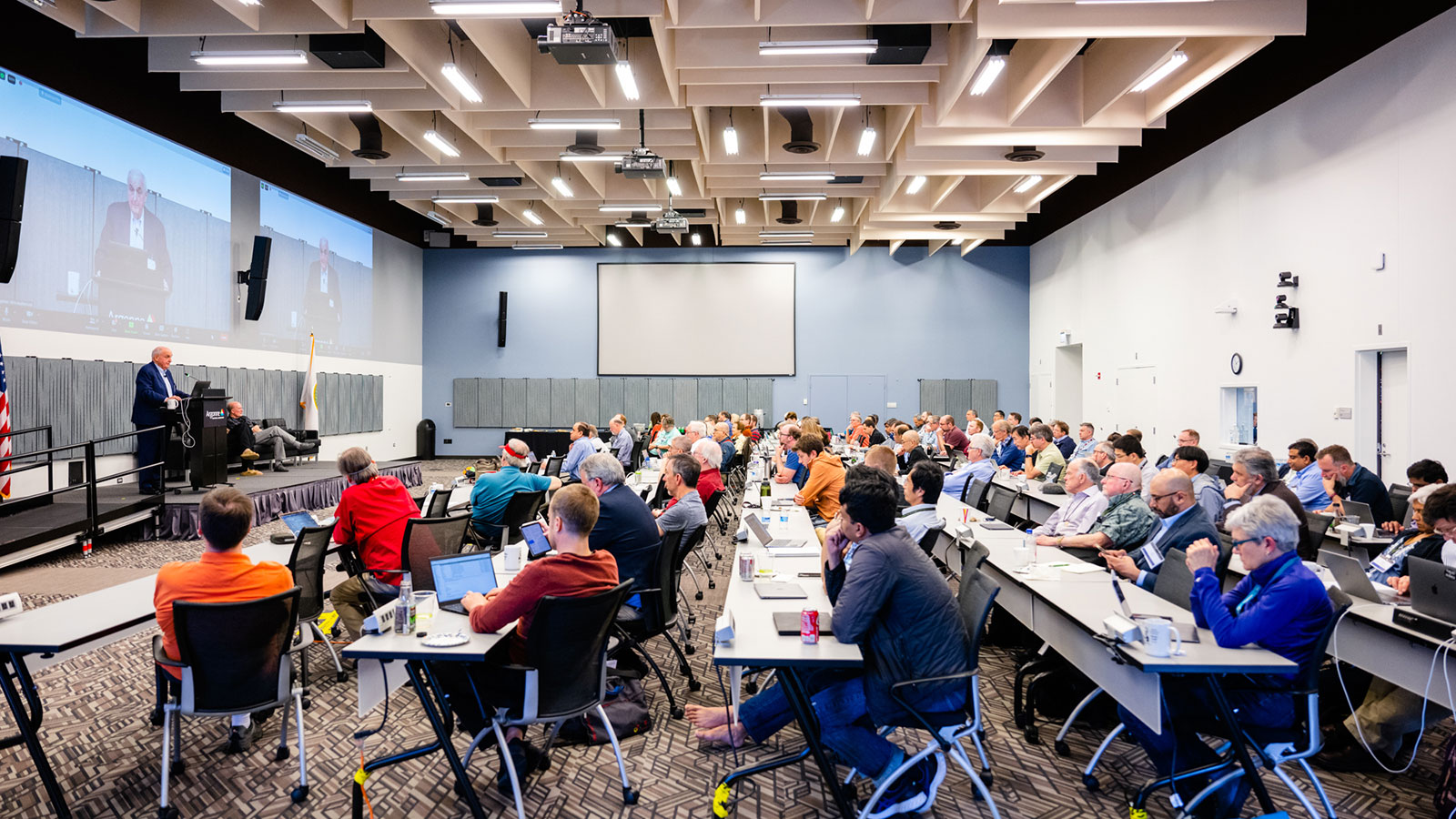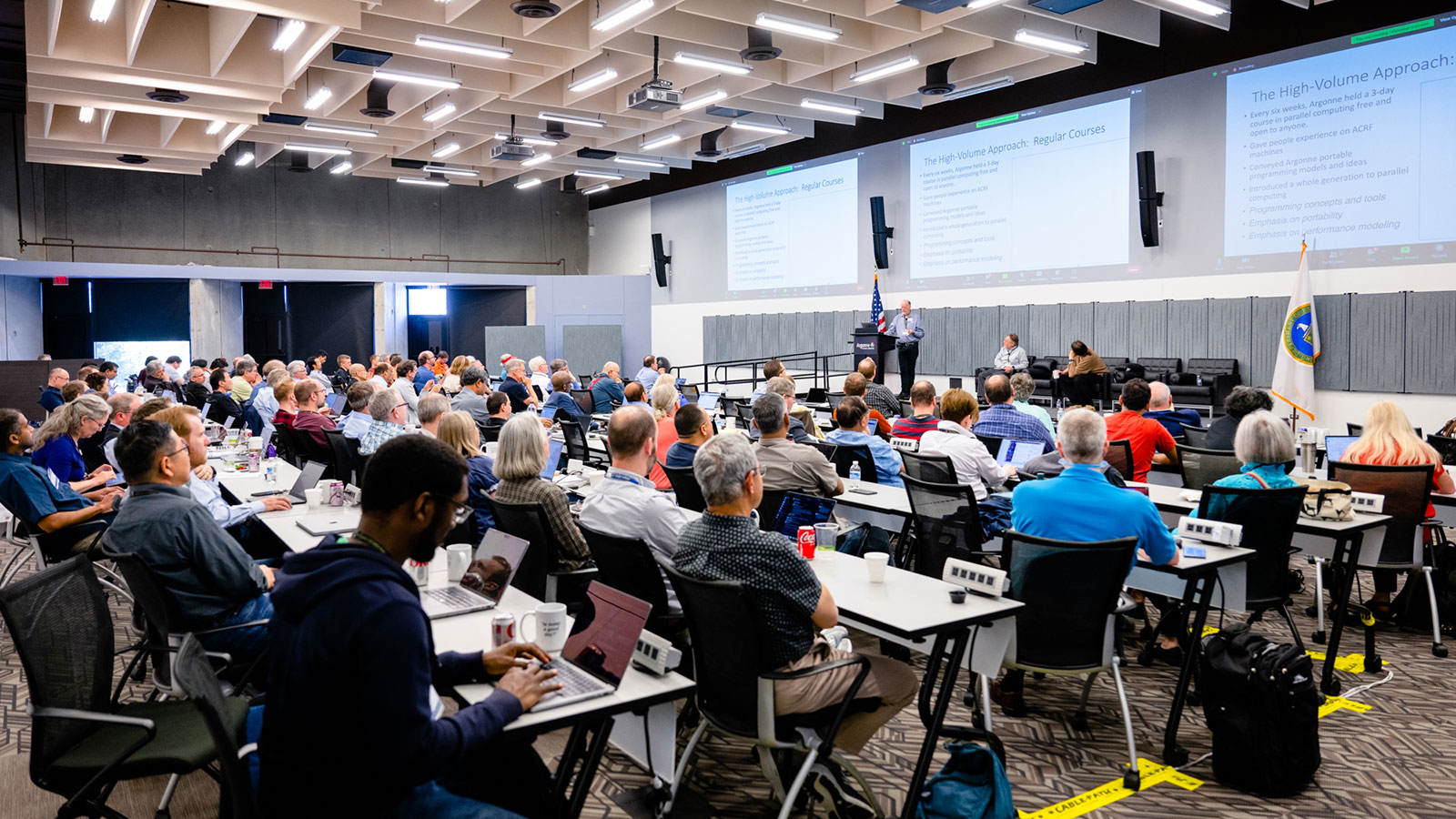
Rusty had a long and distinguished career at Argonne, where he made impactful contributions to the field of computer science and high-performance computing. He ushered in a revolution in parallel computing, helped create the Message Passing Interface standard and shaped the Advanced Computing Research Facility, the precursor to the Argonne Leadership Computing Facility, a DOE Office of Science user facility.
Over 150 colleagues discussed Rusty’s work in automated reasoning and theorem proving, logic programming, parallel computing, message-passing libraries, applications and more, as well as where the field is going in the age of exascale computing.
“Rusty contributed a lot to Argonne and to high-performance computing. He was a friend to so many of us,” said Paul Messina, founding director of Argonne’s Mathematics and Computer Science (MCS) division.
The symposium was organized by Messina, Rajeev Thakur (deputy director of Argonne’s Data Science and Learning division), Rick Stevens (associate laboratory director of Argonne’s Computing, Environment and Life Sciences directorate) and Valerie Taylor (director of Argonne’s MCS division) and was supported by a committee of nine others: Pete Beckman (CELS, Argonne), Barbara Chapman (HPE and Stony Brook University), Jack Dongarra (University of Tennessee and Oak Ridge National Laboratory), Ian Foster (Data Science and Learning division, Argonne), Bill Gropp (University of Illinois at Urbana-Champaign), Paul Hovland (MCS division, Argonne), Mike Papka (Argonne Leadership Computing Facility and University of Illinois at Chicago), Rob Ross (MCS division, Argonne), and Stefan Wild (Lawrence Berkeley National Laboratory). The symposium was sponsored by Hewlett Packard Enterprise, Cerebras, Samsung, Narayan Desai, Rob Schreiber, University of Chicago (Globus Project) and Northwestern Argonne Institute of Science and Engineering.
“Rusty had a huge impact on the field and was a mentor to so many people. We organized the symposium to bring the community together to honor his legacy and discuss future directions for the field,” Thakur said.
The Early Years
Rusty trained as a mathematician, and after receiving his Ph.D. he was a math professor at Northern Illinois University. But he heard about advances in computing and began investigating what this new field was all about. With a not-too-subtle hint to Messina, then the MCS director at Argonne, he was able to join the division where he got involved with automated theorem proving.
Michael McRobbie, university chancellor and president emeritus of Indiana University, spoke of his interactions with Rusty in the mid-1980s, their discussions about automated theorem proving and parallel logic programming, and the impact Rusty had in establishing a parallel computing research facility in Australia.
Stevens described Argonne as “home to one of the leading symbolic AI groups from the early 1960s to the mid-2000s working on automated theorem proving.” He cited the many accomplishments of the Argonne team – winning prizes, writing books, starting a journal, and solving mathematical and logic problems.
But “parallelism was in the air,” Stevens said, and Rusty became intrigued. He and a few Argonne colleagues experimented on a Denelcor HEP-1 at Los Alamos and raised the issue of Argonne starting its own facility. In a roundtable discussion at the symposium, several people discussed the birth of the Advanced Computing Research Facility (ACRF), the numerous experimental machines it acquired and the enormous outreach efforts it sponsored.
Dongarra, who co-led the ACRF with Rusty, gave a glimpse into what it was like to work with Rusty: “He liked to work in pairs, with one person driving (typing) and one navigating (verbally programming). He would write things out by hand as a way of gathering his thoughts, and he tried hard to avoid meetings.”
Stevens described another change within the division. “Around 1990 there was increasing pressure to move from computer science research on programming models and parallel programming to ‘production’ computing,” he said. A scalable cluster system was established and then quickly gave way to a far more ambitious project: the Argonne Leadership Computing Facility.
The MPI Years
Rusty’s middle years at Argonne were distinguished by his work on the Message Passing Interface standard. By the 1990s, massively parallel processing was becoming increasing inevitable, but programming these machines seemed formidable. Nevertheless, the MPI Forum was born, with the goal of establishing a message-passing interface standard. The parallel computing research community and the vendors of computers with parallel architectures felt that converging on a de facto standard would benefit the entire parallel computing community. According to Gropp, “Rusty was a constant supporter of processes that would get us something useful.” He also helped write and edit the MPI documents.
“Writing and editing the MPI documents with Rusty and Bill [Gropp]… was the most enjoyable collaboration in my career,” commented Marc Snir, former director of MCS and emeritus professor at UIUC. An enormous outreach campaign was initiated. Rusty (and others) gave tutorials, wrote several books on MPI and welcomed user feedback to identify points of misunderstanding. Moreover, recognizing the importance of a freely available, portable implementation of the MPI standard, Rusty and his colleagues designed MPICH, which was adopted by virtually all vendors as the initial implementation of the MPI standard on their systems, and later went on to win an R&D 100 award.
Dongarra gave the symposium participants a look at what Argonne was like during those years. He recalled Rusty saying that developing the MPI standard was probably the most important work he had done. But Dongarra emphasized that Rusty did far more – through his team building, his sense of humor and, most of all, his friendship.
Gropp led a panel on “Reasons for MPI’s Success and Lessons for the Future,” which featured Chapman, Lois McInnes (MCS division, Argonne), Tony Skjellum (University of Tennessee at Chattanooga), and Bob Wisniewski (Samsung Advanced Institute of Technology). The panelists stated several reasons for MPI’s success, noting that MPI is now 29 years old. When the MPI Forum first convened, numerous implementations of message-passing systems existed; the Forum members built MPI by leveraging the wisdom and expertise gained from those systems. They carefully crafted abstractions of the functionality in previous systems; got the semantics right; and added models for two-sided communications, datatypes, and other needed functionality that enabled application and library developers to build their software. A third and perhaps most important reason cited was that Rusty (and Gropp and others) wanted to build things that work in operational systems. Related to that was Rusty and Gropp’s implementation of MPICH as the MPI standard was being developed, so that new features and their interactions with previous features could be tested continuously. MPICH provided early availability and was portable.
Expanding into Applications and the Future of Computing
Several presentations focused on applications in which Rusty was involved and on where the field was going with exascale and beyond.
- Paul Fischer (Argonne’s MCS division and UIUC) got to know Rusty during work on the Center for Exascale Simulation for Advanced Reactors project. Fischer talked about the challenges that arise in running at the exascale – scalability, portability, parallelism – all of which were a prime concern of Rusty. He thanked Rusty and the MPI team, noting that “scalable MPI is a critical multiplier on the road to exaflops.”
- Wild, speaking on behalf of Alessandro Lovato (Physics division, Argonne), spoke about Rusty’s ventures into the field of nuclear many-body physics. Intrigued by the “chance to deliver new science at new scales,” Rusty and his colleague Ralph Butler designed and built ADLB, a load-balancing library that proved invaluable for the first ab initio calculations of electron scattering of carbon-12 and for neutrino-nucleus scattering calculations (with Steven Pieper, Physics division, Argonne) as part of the initial Universal Nuclear Energy Density Functional SciDAC project and the subsequent NUCLEI SciDAC project that is still continuing.
- Torsten Hoefler (ETH Zurich) considered the question “What role, if any, does MPI play in modern artificial intelligence?” His answer: For large-scale superlearning, three components are critical: high-performance I/O, compute, and communication. He noted that OpenAI, for example, scaled the open-source system Kubernetes to 7,500 nodes – running MPI.
- Kathy Yelick (UC Berkeley) gave a brief overview of the Exascale Computing Project and why we must continue to rethink our ways of operation. She emphasized the need for new hardware, new software and new applications. Rusty’s work in exploring prototype experimental hardware platforms, in studying logic programming and automated reasoning and in devising new methods and applying them to applications such as theoretical nuclear physics all exemplified how such an approach can indeed lead to new scientific discoveries.
- Foster spoke about programming the computing continuum – that is, an environment in which sensors, actuators, instruments and computing systems are interconnected and execute reliably. MPI and mechanisms such as MPICH-G represented early work toward achieving this computing continuum, and Globus Flows is a more recent example. But many issues remain; and echoing one of Rusty’s oft-repeated phrases, Foster said that we need more “act anywhere” solutions.
A panel on Runtime and System Software for Future Extreme-Scale Systems, led by Beckman, drew on additional viewpoints on current and future software directions presented by Anshu Dubey (MCS division, Argonne), Mary Hall (University of Utah), Satoshi Matsuoka (RIKEN Center for Computational Science) and Jeff Vetter (Oak Ridge National Laboratory). Multiple future directions on the topics of the panel were discussed, including domain-specific languages (DSLs, now at least a decade old but not yet mainstream), building blocks for DSLs and for runtimes; creation of subsets of DSLs and subsets of languages to combat the bloating of languages such as C++; a continued increase in the already large number of programming languages in use; and the fact that specialized modeling may well be an important approach and AI could help develop and implement the models. Leveraging runtime and system software that is used in much bigger markets than HPC was also suggested as a way forward and the use of LLVM in HPC as an early example of the benefits of such a strategy.
A Tremendous Impact
The symposium concluded with a presentation by Messina summarizing Rusty’s professional career and impact – from his early years at Northern Illinois University in the Mathematics Division, to his position as acting director of the newly formed Computer Science Division, to his joining Argonne and co-directing the ACRF and to his participation in the Argonne Training Program on Extreme Scale Computing until 2019. Messina mentioned Rusty’s impact on applications, notably the FLASH astrophysics code and the Green’s function Monte Carlo code (developed by Pieper) for nuclear physics. He listed Rusty’s enormous output of publications and presentations that made parallel programming and MPI a success. And he cited Rusty’s impact through management roles and external professional activities. But most impressive were the pages and pages Messina had collected of the names of people that Rusty collaborated with, mentored, and influenced (numbering over 300).
During the “open mic” session at the symposium dinner, Matsuoka cited an additional impact of Rusty’s work. Matsuoka noted that during the COVID pandemic many of the world’s most powerful computers were used to glean essential information about the spread of the virus, such as that its transmission was airborne and masks could mitigate its spread, and to use models to replicate real-life situations. The knowledge gained was used to combat the transmission of the virus. Those simulations saved millions of lives and allowed society to function. The simulations would not have been possible without the ability to scale simulations to extent they are today thanks to the work of Rusty and others. Therefore, the HPC community and Rusty, in particular, should be credited for saving millions of lives, Matsuoka said.
Messina’s last slide had only five words: “Is Today a Good Day?” Rusty was known for his large collection of coffee mugs, and these were the same words printed on the coffee mug that each symposium participant received. The saying was a favorite of Rusty’s and was always an implicit invitation to get together and discuss anything from the future of high-performance computing to the next party.
Symposium slides and photos are available here.


